Features of watering pepper in a greenhouse
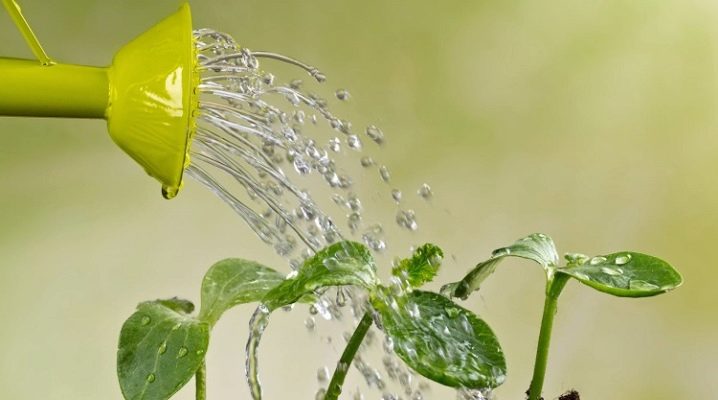
Watering peppers is different from watering some other garden crops, such as carrots and potatoes. This is mainly a southern vegetable, which is extremely difficult to grow in the north, and difficult - in central Russia and other countries located at an approximate latitude with Moscow. This applies not only to spicy, but also to Bulgarian - sweet - pepper.
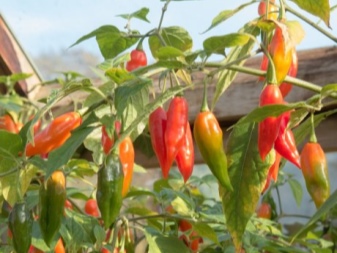

Water temperature and quantity
The vast majority of garden crops do not accept water temperatures below +16 degrees, but 20-30 is considered the norm. Temperatures above +32 degrees can slow down the growth of pepper - as well as too cold, below +16. The water should not be overheated: if it stood in a barrel in the summer heat, and became almost boiling water, it is diluted with cold water (from the mains) to the same +25 degrees, which is the norm. For pepper, +25 is considered an average value, and it is not recommended to deviate from it. Pepper does not "like" uncomfortable conditions for him. The same applies to its planting too early, where water seeping into the ground, which has not warmed up to +16, even if it was warm, will immediately become cold, as soon as the sun hides behind the clouds, or it will begin to set.
It is forbidden to use ice water from a well or well. The quality of the water must also be acceptable: if it is rich, for example, in iron and hydrogen sulfide, then it must be defended so that the hydrogen sulfide evaporates. Iron in the form of soluble nitrous oxide, contained in the "borehole" water, will oxidize and precipitate into a rusty precipitate, which is easy to filter out. The fact is that the excess iron and sulfur contained in the compounds, when infiltrated into the near-surface soil, react with soil organic matter, forming a salt deposit, which is not useful in excess to a person or to vegetables, berry and fruit crops that a person himself eats. To remove iron oxide and hydrogen sulfide, after a long (up to a day) sedimentation, the water is filtered using mechanical and physicochemical methods of purification, which are the basis of treatment facilities.
The amount of water for each bush (one plant) of pepper is up to 6 liters per day.
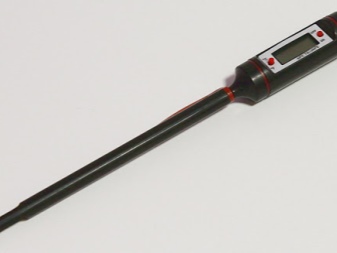
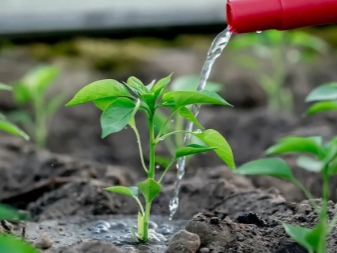
How often should you water?
Bell peppers are watered at least 2 times a day: early in the morning, before sunrise, and in the evening, closer to sunset. Make sure the heat of the day (especially in summer) is over. If you water any plant in the scorching heat, then the overheated soil, rapidly evaporating the water, will create the effect of a double boiler - the relative humidity will jump to almost 100%. The water, although it will cool the soil, will soon heat up with it to +40 or more, and the plants, at best, will wither, at worst they will die out. Pepper, like many crops, will not withstand temperatures, say, + 45 ... 55 degrees. This fully applies to both sweet and bitter types of pepper. The main rule is often and in small portions. If a greenhouse provides full diffused light - for example, its ceiling is made not of transparent, but of white polycarbonate or other cellular plastic that completely excludes direct sunlight, then such material will serve the same service as a translucent cloud cover in the sky. haze from the clouds. In this case, daylight can be left on - but make sure the sun's light is completely diffused and similar to daylight with a solid cloud cover.
Water in the amount of 6 liters, which is recommended by experienced gardeners for watering each pepper plant, is distributed in the morning and evening by 3 liters when watering twice. With three watering times - already 2 liters. You can, of course, install drip pipelines in the greenhouse, a moderate ventilation mode - and not go into it for several days or more: there are no weeds, the soil is weeded, pest remedies are sprayed on schedule, throughout the beds. The wind drift into the greenhouse of new "weedy" seeds, which could germinate there, "strangling" the pepper beds, is completely excluded.
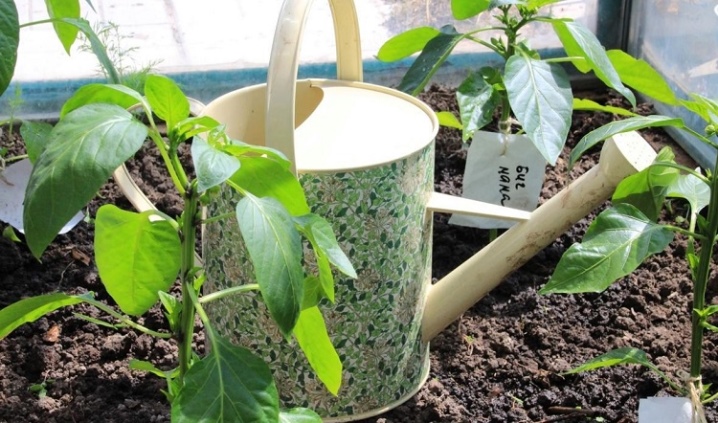
The ways
Having decided on the frequency of watering and the quantity, quality of water, take care of its organization in practice. Watering peppers in a greenhouse made of polycarbonate - or made on the basis of agrofibre - is done manually, mechanically, automatically and in combination.
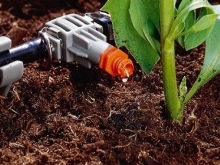
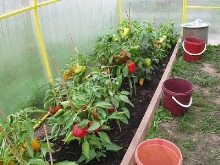
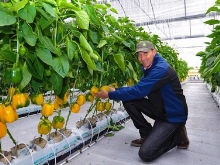
Manual
The advantage of this method is that almost no costs are required. You can water the vegetable beds manually - using a watering can or a hose with a spray nozzle. To get to more distant beds, where it is forbidden to step (since there is no place to put your feet when passing), an additional pipe or pipe piece is required on a watering can or a hose, for example, up to 1 m in length, on which a "watering" nozzle is put on or "shower". A pipe with a spray can be inserted into a standard watering can nozzle or inserted into a hose.
The disadvantage of this method is that the gardener must personally go around all the beds in order to water them. Today's generation of gardeners, who value their time highly, use this method less and less - mainly only at the initial stage, so as not to damage young seedlings and seedlings of pepper.
However, this technique is also being supplanted by automated and mechanical irrigation systems that effectively spray water.
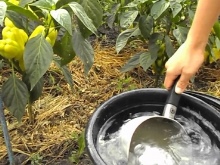
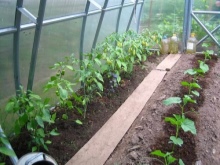
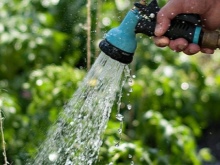
Mechanical
This method is the next step in the development of an irrigation system. Pepper, like any culture, is not afraid of completely wetting the underground part, if, after the end of watering, the greenhouse switches to a stable ventilation mode. Humidity, which is almost 100% during mechanical irrigation, quickly drops to 60%, as soon as the plants dry out. Mechanical watering - the use of (metal) plastic pipes, taps, an electric pump that pumps water from a well or well. No watering cans and a gardener bypassing all rows for the purpose of independent watering is not required: you just need to open the necessary taps after a while - and the beds will be watered. The disadvantage of this method is that the beds must be dug: longitudinal rollers of soil 15-20 cm high separate these beds from each other.
If the pressure is not too high, then the beds are watered in turn: for each - its own tap and its own pipeline. Watering one, move on to the other. The gardener should be near or nearby, and operate on a timer to alternately open and close the taps without significantly increasing the planned water consumption.
The mechanical method is complemented by a drip irrigation system that works constantly, around the clock, when the peppers are not in direct sunlight. In this case, the soil is rather damp - but not swampy, otherwise the pepper would have died out.
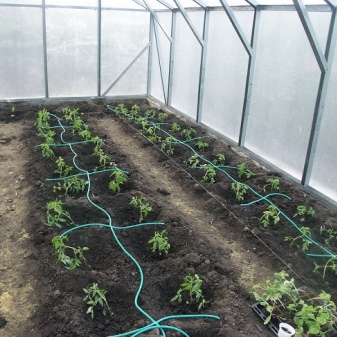
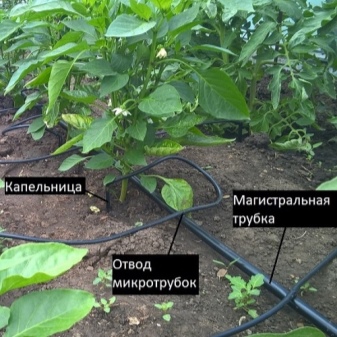
Auto
The automatic method differs from the mechanical method by the presence of sensors installed on each pipe branch connected to a particular bed. And there are also valves that are controlled by an anchor-electromagnetic valve. The valves are controlled by means of a program block operating according to a "timer" schedule. The advantage is complete autonomy: a gardener can work in any other place according to any schedule, almost the whole week does not come to the country. For remote monitoring, a 3G / 4G module is connected to the program unit, which transmits and receives commands over the cellular network - an analogue of "cellular signaling".
Many manufacturers release software applications for computer and mobile operating systems. Through the Android application, a progressive summer resident will request data on the operation of the irrigation system at any time, from anywhere in the world. If the program unit informs him that one of the irrigation pipelines in the greenhouse with pepper did not work, then the owner of the greenhouse can take action. For example, the owner of the greenhouse will ask a relative or neighbor to check why an element of the system did not work and fix the malfunction. Or, if this is not possible, the "non-working" bed will be watered mechanically. The latter is provided by a combined irrigation system.
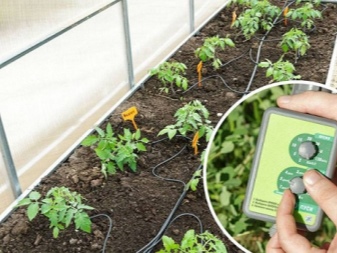

Combined
The combined method combines mechanics and automation. This is the last, most "intelligent" stage in the development of systems. If the program unit has not achieved a clear operation of one or another pipe with a valve, then it sends the owner information about the problem that has arisen. In this case, the second - the same - pipe branch (redundancy in the system) can additionally be involved. Or - with the participation of a gardener - a conventional mechanical-water line is used, equipped with a simple ball valve.
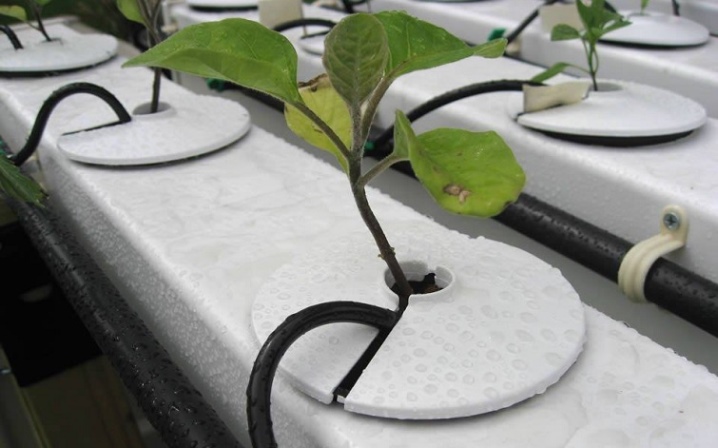
The nuances of watering at different periods
Let's return to the main question - the features of watering bell peppers. No matter how “smart” and thoughtful the irrigation system in your vegetable greenhouse turns out to be, you need to ensure the watering of the pepper correctly. In a greenhouse or greenhouse, in contrast to open ground, certain nuances are used, not taking into account which is fraught with a decrease in yield or even the complete extinction of your "peppery" planting.
After planting the seedlings, if you have not sowed the pepper seeds in the open field immediately, for example, in May, observe a moderate dosage of water. Undoubtedly, 6 liters per day for seedlings is too much. And if this amount of water was poured out carefully, but quickly, spreading over the surface of the soil in a short time, nothing fatal will happen here, except for the excessive consumption of water several times. But when the drip system gives out this amount constantly, pouring the same 6 liters in a thin stream into the soil near each plant, then the soil in the greenhouse will become swampy. The roots of the seedlings will rot before they can grow into full-fledged, adult bushes. Increase the amount of water gradually as the seedlings grow - start with 500 ml per seedling, and gradually bring this amount to the same 6 liters per plant when pepper ovaries appear.
Still, you should not completely and unconditionally trust the automation business. Some kind of supervision - at least infrequent, but periodic - is needed: no one has canceled, for example, the harmful effects of insect pests, mold, fungus and microbes. Protective agents will sooner or later be washed off the surface of plants and soil, volatilizing or seeping into the ground, and they must be reapplied.
There are also cases that the automation can fail, and the owner of the greenhouse and the plantings in it does not immediately know that something went wrong, and the planting - and with them the harvest - is under threat.
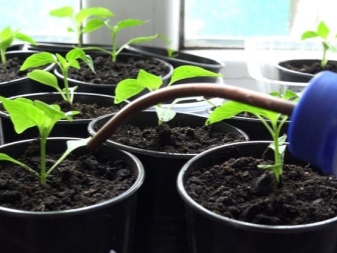
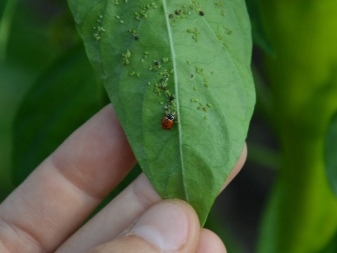
Possible mistakes
In drought, elevated temperatures and in heat, watering should not be carried out without providing diffused light - including when the greenhouse is located in the shade of trees. Do not water in cool weather - for example, in more northern regions - beds in the evening. In most cases, at night, especially in the morning, the temperature drops to the minimum required +10: below this temperature limit, pepper, including Bulgarian pepper, cannot be grown. Then the greenhouse must be heated separately - as happens, for example, in nurseries where indoor, thermophilic varieties are grown. It makes sense to move the bed in special boxes, protected from corrosion, to the house, to a free room, and provide there enhanced illumination when the climate in your area is purely northern.
Air humidity at the stage of fruit ripening should not exceed 80%. For pepper, the minimum limit is 70%. Plants are recommended to be watered at the root. Peppers are not a crop that accepts frequent or constant sprinkling.It is for this reason that bell peppers are grown commercially in greenhouses and greenhouses. Do not water the peppers in frequent, prolonged rains when the roof (ceiling) of the greenhouse is leaking water (made of agrofibre). What nature gives is enough - rainwater is the most "alive". Do not neglect mulching: tops from other crops, pounded to the state of flour or straws, can organically feed the soil, decomposing under the influence of precipitation, watering and light.
Do not forget about fertilizers: potash and phosphate fertilizers spur the growth of both "tops" and the appearance of the largest number of inflorescences, the formation, development and ripening of fruits. The use of fermented chicken, cow and even human excrement as compost will add additional organic matter to the soil, but do not rush to abandon industrial phosphates and potassium salts. But after germinating seedlings and planting them in a greenhouse (or greenhouse) soil, it is better to refuse nitrogen fertilizers: nitrogen is already contained in excess in the soil.
Avoid the formation of a soil crust - loosen it every few days. Loosening is a kind of "dry watering": crust destruction, along with mulching, in the heat at times delays the loss of moisture from the soil.














The comment was sent successfully.